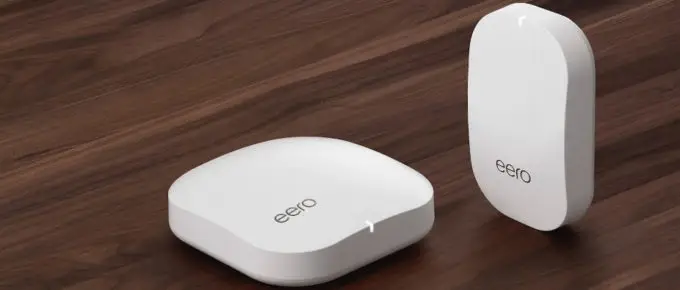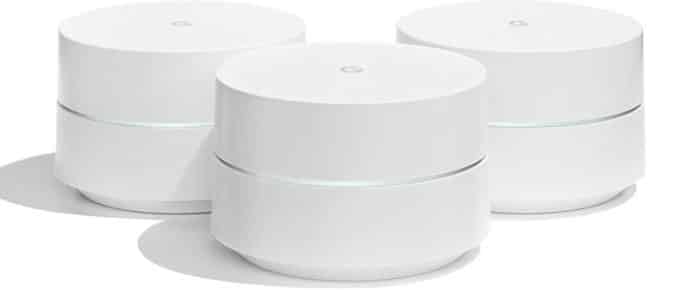If you are confused between Google WiFi Vs. Google Onhub and couldn’t able to decide which one is better, then you have landed at the right place. Smart homes cannot be built on an old router. Having an up-to-date and smart WiFi system will have a big impact on your smart home. Your network’s speed and stability will increase by ten folds. The wireless connectivity market has seen a surge in the past few years. There are tons of smart devices that claim to offer high-tech wireless connections. Today, we will take a look at two: Google WiFi and Onhub TP-Link.
Google WiFi
Quick Navigation
Google WiFi abandons the idea of using routers and WiFi extenders. Instead of these, it banks upon the idea of utilizing multiple points in a house. This helps it to beam a wireless signal across an entire house. Google wasn’t the first to use this idea in the market, but it definitely provided the simplest solution. Mesh networks are now being used by almost every other company including eero. But, Google has managed to promote the idea of mesh networks better than most of its competitors.
Onhub TP-Link
Onhub TP-Link was the first router released by Google a few years ago. It was released with a lot of hype. Onhub was considered to be a game-changer. But, in the years following its release, its features have become less impressive. Other systems like that of eero or Netgear Orbi have overtaken Onhub. Putting all of this aside, Onhub still manages to perform decently. It works especially well with congested networks. The best part of Onhub still remains its reasonable price. The Onhub family has two models: one from TP-Link and the other from Asus. Both of them are compatible with the Google WiFi companion app. But, both TP-Link and Asus have their own advantages and disadvantages. In this comparison, we will be focusing on the TP-Link model and its features. This model was created as part of a collaboration between Google and TP-Link. It was the first model in the Onhub family. It was also the first smart router launched by Google. Initially, Onhub was much more expensive than the rest of its competitors. This was mainly because Onhub had certain differentiating factors i.e. the technology. Onhub had features like Bluetooth 4.0. It was also compatible with ZigBee technology. But, at present both of these features are no longer available. Removal of these features led to a reduction in the price. Due to the reduced price, Onhub became a much more attractive option to customers.Google WiFi Vs. Google Onhub TP-Link : The Verdict
A Comparison Chart
| Specifications | Google Wi-Fi | Google Onhub TP-Link |
|---|---|---|
| Wi-Fi Connectivity | Dual-band WiFi Radios, Simultaneous 2.4GHz and 5GHz IEEE 802.11a/b/g/n/ac | Dual-band WiFi Radios Simultaneous 2.4GHz and 5GHz IEEE 802.11a/b/g/n/ac |
| Wired Connectivity | Two 1GB WAN & LAN USB-C (power) | Two 1GB WAN & LAN 1 x USB 3.0 |
| MU-MIMO | Absent | Absent |
| Bridge Mode | Present | Present |
| Beamforming | Present | Present |
| Reduction of WiFi Dead Zones | Present | Present |
| Security & Network Services | WPA2-PSK | WPA2-PSK |
| Range | One 500-1500 sq ft Two 1500-3000 sq ft Three 3000-4500 sq ft | One 2,500 sq ft |
| Memory | 512MB | 1GB |
| Storage Capacity | 4GB | 4GB |
| Subscription Package | Absent | Absent |
| Antennas | 5 | 13 |
| Processor | Quad-core 710 MHz | Dual-core 1.4GHz |
| Dimensions | Diameter: 4.1” Height: 2.7” | 7.5” x 4.1” x 4.6” |
| Color | White | Blue and Black |
| Speaker | Absent | Present |
| Price | Check Price | Check Price |
Differences
1. Performance And Antennas
Google WiFi: Google WiFi and Onhub TP-Link differ in the number of antennas they have. The performance of these antennas also differs vastly. By antennas, we mean the equipment inside the router itself. This excludes the nodes that combine together to form a mesh network. The Google WiFi has an array of five antennas. Four of these antennas are WiFi and the fifth one is Bluetooth. All of these antennas are arranged around the circumference of the device. Google WiFi can deliver a combined throughput of 465.4 megabits. This can be delivered at a range of 5 feet. For 15 feet, the throughout stopped at 450.2 Mbps. For 50 feet, it stopped at 389.7 Mbps. This may be a considerable drop-off. But, Google WiFi is actually ahead of its competitors in this space. But, this doesn’t mean that Google WiFi doesn’t witness a performance drop. There will be a decrease in speed in proportion to the distance from the router. But, Google WiFi is slightly better than the other products.
Onhub TP-Link: The Onhub TP-Link has 13 antennas. These antennas are placed in a circle around the interior of the router. Six of these antennas work with the 5GHz band. Another six work for the 2.4GHz band. The remaining one helps in boosting the signal. It might look that Onhub might win this round because it has a number of antennas. But, that is not true. Onhub actually has two more antennas. These antennas were initially used for supporting the Bluetooth and ZigBee technology. Onhub doesn’t support this technology anymore. This means that the two antennas are effectively useless. Onhub supports throughput of 1.9 Gbps at its peak. This might sound impressive in theory. But, Onhub’s performance during testing was not that impressive. At a close range, Onhub’s performance was disappointing. At a distance of 5 feet, it did 265.3 Mbps, with a 3.4-millisecond latency. At a distance of 140 feet, it avoided a drop-off at 104.9 Mbps. Despite this, the overall speed of Onhub is much slower than Google WiFi. The technology is slightly outdated as well. Onhub is not a good choice when it comes to the current smart WiFi market. This is because it’s data transmission performs poorly compared to Google WiFi.
Winner: Google WiFi.
2. Hardware
Google WiFi: The Google WiFi router has a Quad-Core ARM CPU. Google WiFi has 4 cores that each run at 710 MHz. This might seem insignificant when compared to Onhub TP-Link. But, the most important part of the device is the underlying RAM. It is the RAM that powers the device. Google WiFi has 512 MB of RAM. This is more than enough to keep Google WiFi running smoothly. But, it is nothing compared to that of Onhub TP-Link. Google WiFi has a flash memory of 4GB which is pretty decent.
Onhub TP-Link: The overall power of the hardware on Onhub TP-Link is far superior to that of Google’s. The Onhub features a 1.4 GHz Qualcomm processor. This is based upon the Snapdragon 600 line of chips. In terms of horsepower, Onhub has the power of a mid-range tablet. Onhub TP-Link has a dual-core setup that runs at 1.4 GHz. In this aspect, Google WiFi and Onhub TP-Link are very evenly matched. The only edge that Onhub has is that it offers 1 GB of memory, which is nearly twice as that of Google WiFi. Onhub also has a flash memory of 4 GB. Onhub also allows the software to run when it starts up.
This is a great feature as it reduces the chances of someone hacking into your router. All of this makes it seem that Onhub has better hardware overall. But, here’s the catch. Although Onhub has more power than that of Google, it hasn’t been able to utilize this power efficiently. This is mainly because the ZigBee and Bluetooth technology are disabled. This leads to a less impressive speed performance by Onhub. Google WiFi may be at a disadvantage when it comes to hardware. But, it will deliver consistent performance across your entire home.
Winner: Google WiFi.
3. Range
Google WiFi: Google WiFi allows you to integrate multiple units. As the number of satellites increase, so will the range. A single unit of Google WiFi is enough for a small home or apartment. It can provide reliable and fast connectivity in a range of 500-1500 square feet. Two units will suffice for a medium-sized apartment. It will provide a range of 1500-3000 square feet. A large property will require three WiFi units. The internet can be beamed at a range of 3000-4500 square feet.
Onhub TP-Link: A standalone unit of Onhub can cover 2500 square feet of a home. But, Onhub does not have any scope for expansion. Onhub is not the best option if you are looking for a mesh network that can be expanded. However, the saving grace here is that Onhub can be integrated into a Google WiFi system.
Winner: Google WiFi.
4. Nightlight
Google WiFi: One area in which Google WiFi lacks is in the overall look of the router. Google WiFi does not come with a Nightlight.
Onhub TP-Link: The nightlight is a pretty unique feature of Onhub TP-Link. It is not a traditional nightlight. The lights on the device can be adjusted. You can adjust the lights to be bright enough to illuminate even a small area. The Onhub also includes a light sensor. This sensor allows the nightlight to turn on and off based on the ambient lighting. You only have to adjust the lighting levels manually. The nightlight is not that big of a deal-breaker when it comes to Google WiFi. But, an extra feature could never hurt anyone, right?
Winner: Onhub TP-Link.
5. Speaker
Google WiFi: Google WiFi is again at a disadvantage when it comes to this feature. Google WiFi does not come with any speaker. But, this does not affect the router’s performance in any way.
Onhub TP-Link: As mentioned earlier, the Onhub has an LED ring that can operate as a nightlight. The Onhub also has a speaker on the top of the device. This is very unique for a smart WiFi system. The feature while being unique, is not that useful either. Features like that of an intercom, smart doorbell, the audio doorbell would have been better. But all of them are lacking in Onhub. The speaker on the device is mainly used for setup purposes. It alerts you when a new client tries to connect to the system. Google support also said that they will not be adding speaker features in the future. This means that Onhub is probably the last system to have the feature.
Winner: Onhub TP-Link.
6. Design
Google WiFi:. The designs of Google WiFi and Onhub TP-Link are vastly different. One Google WiFi unit is compact and comes in a cylindrical case. The case is fingerprint-resistant and has a glossy white finish. The device is cut down in the middle. This is done in order to leave space for the LED light. The LED light encircles the Google WiFi completely. The router also measures 4.1 x 2.7 inches. It has a weight of 12 ounces. The Google WiFi is small enough to fit almost anywhere. The weight is such that the device cannot be knocked over easily. The Google WiFi is very well-designed and we cannot really find any fault with its design.
Onhub TP-Link: The Onhub has a different look than that of a regular router. The system is not rectangular, like most of the other systems are. The Onhub has a design that is very unique. It is shaped like a cone with its bottom cut off. The Onhub looks like an artistic sculpture rather than a networking equipment. The device is available with a blue or dark-blue cover. It comes with an aluminum base that measures 4.1 x 4.6 x 7.5 inches. Both the devices do have an attractive design, but we would be lying if we said that Onhub doesn’t look more unique.
Winner: Onhub TP-Link.
7. Accessories
Google WiFi: Google WiFi and Onhub TP-Link can function really well on their own. But, using certain accessories can enhance the overall performance of the router. For Google WiFi, you can purchase the Google WiFi Wall Outlet Mount or a Wall/Ceiling Mount. You can also purchase the Google Router Mounting Bracket. This accessory offers more flexibility and control during installation. It is a very useful accessory for Google WiFi users.
Onhub TP-Link: The accessories for Onhub are known as Shells. They are basically an outer covering that can be fitted over the device. The shells come in different colors and are interchangeable. You can change the shells as per the decor of your home. Routers are usually kept out in the open. So, these shells will come in handy for homeowners who want to retain the stylish look of their smart home. The shells are a great addition. But, Onhub still doesn’t have a lot of accessories that will help to enhance its performance.
Winner: Google WiFi.
Similarities
1. Reduction Of WiFi Dead Zones
Reducing WiFi Dead Zones is one of the most important functions of any WiFi system. Traditional routers were typically unable to beam consistent signals across an entire house. This is mainly because there are a lot of obstructions within a house. The online reliability is very low in these cases. Onhub and Google WiFi come equipped with a solution to these problems. You will not have to run around your house looking for a signal. Instead, Onhub and Google WiFi will maintain the same connection no matter where you are. The routers are also easily movable. According to your convenience, you can shift it to a more favourable location. Shifting the router will build a faster and reliable connection. There are also apps that can be used to prevent the signal from dropping off completely. Some of these apps include WiFi Sweetspots for IOS and WiFi Analyzer for Android. They automatically adjust the location of your router when the signal starts dropping.
2. Dual Band WiFi Radios
Google WiFi and Onhub TP-Link both have dual-band WiFi radio. Dual-band radio means that your device will have two different bands. The device can choose between the two bands. It will receive and send data from the chosen band. The bands are in two frequencies- a 2.4 GHz and a 5 GHz IEEE 802.11a/b/g/n/ac. Having access to both these bands helps to provide the network a little more support. It enables the network to support a lot of simultaneous connections. Devices tend to compete for bandwidth, so the dual-band radio will be of major help in such cases.3. Two Gigabit Ethernet Ports
The major reason to buy a router is to secure a strong WiFi connection. But, having a router that supports a hardwired connection is advantageous too. The Google WiFi has two gigabit Ethernet ports per WiFi point. This will allow you to connect devices like gaming PCs or smart home hubs. But, one of the two ports on the router will be used to connect to the modem. The Google WiFi also has a USB-C port which will help to power each device. Meanwhile, Onhub has 1 WAN, 1 LAN, and one USB 3.0 port. The Onhub setup will keep your home free from the process of hooking up a lot of wires. But, you will have to purchase a switch for hardwiring connections. Both Google WiFi and Onhub aren’t the best when it comes to Ethernet ports. The better option would be Netgear Orbi, which we recommend you to check out.
4. Smart Home Support
Smart WiFi Systems play a major role in supporting modern technology and setting up a smart home. Google WiFi and Onhub TP-Link have LAN ports. You can use these ports to plug in hardwired devices. Controllers like the Wink hub 3 and SmartThings Gen 3 can be plugged in to the device. They offer a reliable and speedy network connection.
5. No Subscription Package
Most routers and mesh networks have a subscription package. You need to subscribe in order to access the full features of the device. You have to pay an additional fee in order to use features like security or parental controls. The good thing about Google WiFi and Onhub TP-Link is that they have no such subscription. You can access all of the features without having to pay extra. All the features of both the devices are unlocked by default. The only thing you have to pay is the initial purchase fee. You can then enjoy the smart WiFi without paying any additional costs.
6. Easy To Set Up
Google WiFi and Onhub TP-Link both have an easy installation process. For Onhub, you need to create a Google account if you don’t already have one. A bonus here is that Google has assured that they will not monitor the user’s data. Your personal data will not be given to advertisers who can target you with specialised ads. For setting up, you have to download and install the Google On app. The Google On app is available for both IOS and Android. You then have to plug your router and boot up the app. The Onhub network will be able to start within 5 minutes. The Google WiFi has a plug and play setup. The requirements for setting up Google WiFi include a modem, an outlet and a mobile app. You just have to set up the modem and install the mobile application and the process is completed. Like we said, both the routers have a simple set up process.
Google WiFi : Product Features & Technical Specifications
- Compatibility – Google WiFi can replace your current router. It is able to work with your modem and internet services. Google WiFi is compatible with almost all major internet service providers. Google WiFi can work with Comcast, Time Warner and Verizon Fios.
- Range – A single Google WiFi has a range of up to 1500 sq. ft. Three units can easily cover homes up to 4500 sq.ft. The WiFi points are capable of working together. So, you can add more for additional coverage.
- Network Assist Technology – This technology helps in keeping your connection fast. It selects the clearest channel and the fastest band for your devices.
- Computer Memory Type – Google uses DDR3 SDRAM; Voltage- 120240 Volts.
- Wireless Frequency – 2.4 GHz Radio Frequency, 5 GHz Radio Frequency, 802.11a/b/g/n/ac.
- Requirements for Setting Up – You will need a Google account. An Operating System -Windows or 4.0+ for Android device and IOS 8+ for IOS devices. Apart from this, you need the Google WiFi app, a broadband Internet connection and a modem.
- Dimensions – Google WiFi has dimensions that measure 4.2 x 4.2 x 2.7 inches.
- Weight – Google WiFi weighs 12oz (340g) each.
- Processor – Google WiFi has a Quad-core ARM CPU, with each core up to 710 MHz).
- Beamforming – 2.4 and 5 GHz bands have Implicit and Explicit beamforming.
Google Onhub TP-Link : Product Features & Technical Specifications
- Compatibility – Google Onhub TP-Link works well with all major internet service providers.
- Range – A single unit can cover up to 2500 sq.ft for most homes.
- Network Assist Technology – This technology helps in keeping your connection fast. It selects the clearest channel and the fastest band for your devices.
- Wireless Frequency – 2.4 GHz at 600 Mbps Radio Frequency, 5 GHz at 1300 Mbps Radio Frequency, IEEE 802.11a/b/g/n/ac.
- Dimensions – Google Onhub TP-Link has dimensions that measure 4.1 x 4.6 x 7.5 inches.
- Weight – Google Onhub TP-Link weighs 1.9 pounds with a shipping weight of 3.6 pounds.
Google WiFi: What You Get In A Box
The Google WiFi box will contain three Google WiFi points. There will also be USB(C) adaptors and an Ethernet cable. A Google Let’s Get Started Guide is included. It will give you details about setting up and using the Google WiFi.
Google Onhub TP-Link: What You Get In A Box
The Google Onhub Onhub TP-Link box contains the Onhub, of course. It also contains two Ethernet cables and a power adaptor. The standard guidelines on how the Onhub must be set are also included in a brochure.
Frequently Asked Questions
1. Can A Guest Network Be Set Up Apart From the Main Home Network?
Yes, an isolated guest network can be set up apart from the main home network. Devices that are used on the main network can also be made accessible for the guest network.
2. Can the Home Network be Accessed from Outside?
Yes, the home network can be accessed from outside. This can be done via the Google WiFi app. You can change the admin settings and manage the network remotely.
3. Does Google WiFi work with Spectrum WiFi?
Yes, Google WiFi works with Spectrum WiFi.
4. Can Google WiFi work as a range extender?
No, Google WiFi cannot function as a range extender.
5. How Many Devices Can Be Connected To The Onhub TP-Link?
More than 100 devices can easily be connected to the Onhub TP-Link. There is an easy-to-setup network that allows each device to connect easily to the router.
6. What Is The Average WiFi Speed of The Onhub TP-Link?
Onhub TP-Link provides fast WiFi speeds up to 1900 mbps. If you are streaming or downloading a large file then you can automatically boost the WiFi speed. This will allow you to increase the speed on the device that you are using for the downloading.
7. Are Batteries Required for Onhub TP-Link?
Yes, batteries are required for Onhub TP-Link. It requires 1 Lithium ion battery.
Final Talk
Google WiFi beats Onhub TP-Link by a narrow margin. The only real advantage that the Onhub has over Google WiFi is the larger range for a single unit. But, Google WiFi’s mesh network renders this advantage useless. The silver lining here is that Onhub TP-Link can be expanded by adding a Google WiFi point. This retains your existing setup but with an increased range. So, if you are still confused between Google WiFi and Onhub TP-Link, then buy them both as they work well together!Google WiFi system - Editor's Choice
Summary
Google WiFi can deliver a combined throughput of 465.4 megabits. This can be delivered at a range of 5 feet. For 15 feet, the throughout stopped at 450.2 Mbps. For 50 feet, it stopped at 389.7 Mbps. This may be a considerable drop-off. But, Google WiFi is actually ahead of its competitors in this space.









Leave a Reply